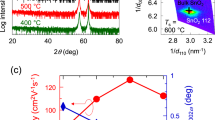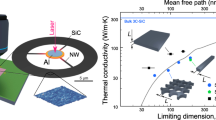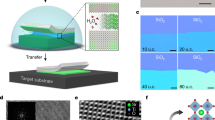Abstract
The widely used ‘silicon-on-insulator’ (SOI) system consists of a layer of single-crystalline silicon supported on a silicon dioxide substrate. When this silicon layer (the template layer) is very thin, the assumption that an effectively infinite number of atoms contributes to its physical properties no longer applies, and new electronic, mechanical and thermodynamic phenomena arise1,2,3,4, distinct from those of bulk silicon. The development of unusual electronic properties with decreasing layer thickness is particularly important for silicon microelectronic devices, in which (001)-oriented SOI is often used5,6,7. Here we show—using scanning tunnelling microscopy, electronic transport measurements, and theory—that electronic conduction in thin SOI(001) is determined not by bulk dopants but by the interaction of surface or interface electronic energy levels with the ‘bulk’ band structure of the thin silicon template layer. This interaction enables high-mobility carrier conduction in nanometre-scale SOI; conduction in even the thinnest membranes or layers of Si(001) is therefore possible, independent of any considerations of bulk doping, provided that the proper surface or interface states are available to enable the thermal excitation of ‘bulk’ carriers in the silicon layer.
This is a preview of subscription content, access via your institution
Access options
Subscribe to this journal
Receive 51 print issues and online access
$199.00 per year
only $3.90 per issue
Buy this article
- Purchase on Springer Link
- Instant access to full article PDF
Prices may be subject to local taxes which are calculated during checkout



Similar content being viewed by others
References
Lu, Z. H., Lockwood, D. J. & Baribeau, J. M. Quantum confinement and light-emission in SiO2/Si superlattices. Nature 378, 258–260 (1995)
Legrand, B., Agache, V., Nys, J. P., Senez, V. & Stievenard, D. Formation of silicon islands on a silicon on insulator substrate upon thermal annealing. Appl. Phys. Lett. 76, 3271–3273 (2000)
Liu, W. & Asheghi, M. Phonon-boundary scattering in ultrathin single-crystal silicon layers. Appl. Phys. Lett. 84, 3819–3821 (2004)
Liu, F., Huang, M. H., Rugheimer, P. P., Savage, D. E. & Lagally, M. G. Nanostressors and the nanomechanical response of a thin silicon film on an insulator. Phys. Rev. Lett. 89, 136101 (2002)
Celler, G. K. & Cristoloveanu, S. Frontiers of silicon-on-insulator. J. Appl. Phys. 93, 4955–4978 (2003)
Kim, Y. A 0.25 mm 600MHz 1.5V SOI 64b ALPHATM microprocessor. ISSCC Dig. Tech. Pap. I, 432–433 (1999)
Yan, R. H., Ourmazd, A. & Lee, K. F. Scaling the Si MOSFET — From bulk to SOI to bulk. IEEE. Trans. Electron. Dev. 39, 1704–1710 (1992)
Sutter, P., Ernst, W. & Sutter, E. Scanning tunneling microscopy on ultrathin silicon on insulator (100). Appl. Phys. Lett. 85, 3148–3150 (2004)
Lin, K. C., Holland, O. W., Feldman, L. C. & Weitering, H. H. Surface characterization of silicon on insulator material. Appl. Phys. Lett. 72, 2313–2315 (1998)
Hovel, H. et al. Status of 300 mm SOI material: comparisons with 200 mm. Proc. Electrochem. Soc. 2003–05, 75–80 (2003)
Swartzentruber, B. S., Kitamura, N., Lagally, M. G. & Webb, M. B. Behavior of steps on Si(001) as a function of vicinality. Phys. Rev. B 47, 13432–13441 (1993)
Tromp, R. M., Hamers, R. J. & Demuth, J. E. Si(001) dimer structure observed with scanning tunneling microscopy. Phys. Rev. Lett. 55, 1303–1306 (1985)
Fontes, E., Patel, J. R. & Comin, F. Direct measurement of the asymmetric dimer buckling of Ge on Si(001). Phys. Rev. Lett. 70, 2790–2793 (1993)
Schroder, D. K. Semiconductor Material and Device Characterization (Wiley & Sons, New York, 1998)
McWhorter, P. J. & Winokur, P. S. Simple technique for separating the effects of interface traps and trapped-oxide charge in metal-oxide-semiconductor transistors. Appl. Phys. Lett. 48, 133–135 (1986)
Cristoloveanu, S. & Sheng, L. Electrical Characterization of Silicon-on-Insulator Materials and Devices (Kluwer, Boston, 1995)
Northrup, J. E. Electronic structure of Si(100)C(4x2) calculated within the GW approximation. Phys. Rev. B 47, 10032–10035 (1993)
Stroscio, J. A. & Ho, W. Long-range quasielastic scattering of low-energy electrons by conduction-band surface-plasmons on Si(111)7x7. Phys. Rev. Lett. 54, 1573–1576 (1985)
Heike, S., Watanabe, S., Wada, Y. & Hashizume, T. Electron conduction through surface states of the Si(111)-(7x7) surface. Phys. Rev. Lett. 81, 890–893 (1998)
Tanikawa, T., Matsuda, I., Kanagawa, T. & Hasegawa, S. Surface-state electrical conductivity at a metal-insulator transition on silicon. Phys. Rev. Lett. 93, 016801 (2004)
Petersen, C. L., Grey, F., Shiraki, I. & Hasegawa, S. Micro-four-point probe for studying electronic transport through surface states. Appl. Phys. Lett. 77, 3782–3784 (2000)
Yoo, K. & Weitering, H. H. Electrical conductance of reconstructed silicon surfaces. Phys. Rev. B 65, 115424 (2002)
Chen, D. X. & Boland, J. J. Chemisorption-induced disruption of surface electronic structure: Hydrogen adsorption on the Si(100)-2x1 surface. Phys. Rev. B 65, 165336 (2002)
Chen, D. X. & Boland, J. J. Spontaneous roughening of low-coverage Si(100)-2x1: Cl surfaces: Patch formation on submonolayer halogenated surface. Phys. Rev. B 70, 205432 (2004)
Hollinger, G. & Himpsel, F. J. Oxygen chemisorption and oxide formation on Si(111) and Si(100) surfaces. J. Vac. Sci. Technol. A 1, 640–645 (1983)
Hamers, R. J. et al. Cycloaddition chemistry of organic molecules with semiconductor surfaces. Acc. Chem. Res. 33, 617–624 (2000)
Seino, K., Schmidt, W. G. & Bechstedt, F. Organic modification of surface electronic properties: A first-principles study of uracil on Si(001). Phys. Rev. B 69, 245309 (2004)
Meuris, M. et al. The IMEC clean — A new concept for particle and metal removal on Si surfaces. Solid State Technol. 38, 109–114 (1995)
Acknowledgements
This research was supported by the US National Science Foundation, the US Department of Energy, and the US Air Force Office of Scientific Research.
Author information
Authors and Affiliations
Corresponding author
Ethics declarations
Competing interests
Reprints and permissions information is available at npg.nature.com/reprintsandpermissions. The authors declare no competing financial interests.
Rights and permissions
About this article
Cite this article
Zhang, P., Tevaarwerk, E., Park, BN. et al. Electronic transport in nanometre-scale silicon-on-insulator membranes. Nature 439, 703–706 (2006). https://doi.org/10.1038/nature04501
Received:
Accepted:
Issue Date:
DOI: https://doi.org/10.1038/nature04501
This article is cited by
-
Feasibility of a multigroup Boltzmann–Fokker–Planck solution for electron beam dose calculations
Scientific Reports (2023)
-
Formation of Globally Uniaxial Strain in He+ Implanted Silicon-on-Insulator Wafers Based on the Size Effect of Internal Stress of Strip SiN Films
Silicon (2023)
-
The Strain Model for Globally Strained Silicon on Insulator Wafer Based on High-stress SiN Film Deposition
Silicon (2023)
-
Si nanomebranes: Material properties and applications
Nano Research (2021)
-
Spatial mapping of band bending in semiconductor devices using in situ quantum sensors
Nature Electronics (2018)
Comments
By submitting a comment you agree to abide by our Terms and Community Guidelines. If you find something abusive or that does not comply with our terms or guidelines please flag it as inappropriate.



